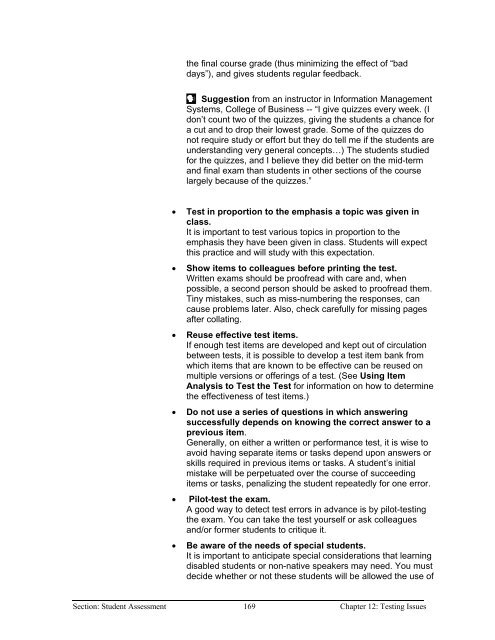Chapter 9 - Instructional Media: Chalkboards to Video - CGISS
Chapter 9 - Instructional Media: Chalkboards to Video - CGISS
Chapter 9 - Instructional Media: Chalkboards to Video - CGISS
Create successful ePaper yourself
Turn your PDF publications into a flip-book with our unique Google optimized e-Paper software.
the final course grade (thus minimizing the effect of “bad<br />
days”), and gives students regular feedback.<br />
Suggestion from an instruc<strong>to</strong>r in Information Management<br />
Systems, College of Business -- “I give quizzes every week. (I<br />
don’t count two of the quizzes, giving the students a chance for<br />
a cut and <strong>to</strong> drop their lowest grade. Some of the quizzes do<br />
not require study or effort but they do tell me if the students are<br />
understanding very general concepts…) The students studied<br />
for the quizzes, and I believe they did better on the mid-term<br />
and final exam than students in other sections of the course<br />
largely because of the quizzes.”<br />
• Test in proportion <strong>to</strong> the emphasis a <strong>to</strong>pic was given in<br />
class.<br />
It is important <strong>to</strong> test various <strong>to</strong>pics in proportion <strong>to</strong> the<br />
emphasis they have been given in class. Students will expect<br />
this practice and will study with this expectation.<br />
• Show items <strong>to</strong> colleagues before printing the test.<br />
Written exams should be proofread with care and, when<br />
possible, a second person should be asked <strong>to</strong> proofread them.<br />
Tiny mistakes, such as miss-numbering the responses, can<br />
cause problems later. Also, check carefully for missing pages<br />
after collating.<br />
• Reuse effective test items.<br />
If enough test items are developed and kept out of circulation<br />
between tests, it is possible <strong>to</strong> develop a test item bank from<br />
which items that are known <strong>to</strong> be effective can be reused on<br />
multiple versions or offerings of a test. (See Using Item<br />
Analysis <strong>to</strong> Test the Test for information on how <strong>to</strong> determine<br />
the effectiveness of test items.)<br />
• Do not use a series of questions in which answering<br />
successfully depends on knowing the correct answer <strong>to</strong> a<br />
previous item.<br />
Generally, on either a written or performance test, it is wise <strong>to</strong><br />
avoid having separate items or tasks depend upon answers or<br />
skills required in previous items or tasks. A student’s initial<br />
mistake will be perpetuated over the course of succeeding<br />
items or tasks, penalizing the student repeatedly for one error.<br />
• Pilot-test the exam.<br />
A good way <strong>to</strong> detect test errors in advance is by pilot-testing<br />
the exam. You can take the test yourself or ask colleagues<br />
and/or former students <strong>to</strong> critique it.<br />
• Be aware of the needs of special students.<br />
It is important <strong>to</strong> anticipate special considerations that learning<br />
disabled students or non-native speakers may need. You must<br />
decide whether or not these students will be allowed the use of<br />
Section: Student Assessment 169 <strong>Chapter</strong> 12: Testing Issues
















